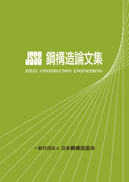
- Issue 100 Pages 100_1・・・
- Issue 99 Pages 99_1-
- Issue 98 Pages 98_1-
- Issue 97 Pages 97_1-
- |<
- <
- 1
- >
- >|
-
Koji KINOSHITA, Taichi KAJITA2018 Volume 25 Issue 98 Pages 98_1-98_7
Published: June 29, 2018
Released on J-STAGE: May 22, 2019
JOURNAL FREE ACCESSThis study investigates weldability of welded joints of SBHS700 based on Y-groove weld cracking test. This study tried to prevent weld cracking: hot cracking and cold cracking by using under-matching welded joints with ultra-low hydrogen weld materials. As a result, although both hot cracking and cold cracking were observed in the tests, any weld crack has not been observed in under-matched welded joints that used ultra-low hydrogen weld materials. Consequently, this study may conclude that it is not necessary for SBHS700 under-matching welded joints having under 32 mm plate thickness using ultra-low hydrogen weld materials to conduct the pre-heating.
View full abstractDownload PDF (1584K) -
Koki OKADA, Masahiro SAKANO, Hideyuki KONISHI, Masahiro KOYAMA2018 Volume 25 Issue 98 Pages 98_9-98_22
Published: June 29, 2018
Released on J-STAGE: May 22, 2019
JOURNAL FREE ACCESSRetrofitting method against fatigue cracking at the upper end of web gap plates under RC slab is investigated. In this method, TRS (Thread Rolling Screw) is used to attach angle steel to upper flange, and HTB (High Tension Bolt) is used to connect angle steels to web gap plate. The effectiveness of the method is investigated through fatigue tests using a beam specimen with the web gap detail of the same size as the actual bridge. As a result, the method can reduce the local stress concentration at crack initiation points to about 50~60 %, and extend fatigue crack initiation life more than 2~6 times and fatigue crack propagation life more than 100 times after grinding away fatigue cracks.
View full abstractDownload PDF (5028K) -
~ABOUT 490N/mm2 GRADE STEEL,780N/mm2 GRADE STEEL~Junya MIYATAKE, Yosuke NAKAJIMA, Hirofumi KANEKO, Kenji YAMAZAKI, Taku ...2018 Volume 25 Issue 98 Pages 98_23-98_33
Published: June 29, 2018
Released on J-STAGE: May 22, 2019
JOURNAL FREE ACCESSThe current width to thickness ratio criteria in the Japanese standard do not allow high-strength steel to be used in practice. According to the criterion, high-strength steel results in excessive cross section since it underestimate its deflection angle at maximum strength. Considering that, it would be appropriate to consider the original yield strength retains until steel reaches a certain deflection angle. The purpose of the present paper is to study relationship between the deflection angle at maximum strength and width to thickness ration. The paper deals with plates of 490N/mm2 grade steel and 780N/mm2 grade steel and discusses their relationship by means of FEM analysis.
View full abstractDownload PDF (1706K) -
Kazutoshi NAKASHIMA, Isamu KANO, Hiromichi YASUNAMI, Chihiro MORITA2018 Volume 25 Issue 98 Pages 98_35-98_43
Published: June 29, 2018
Released on J-STAGE: May 22, 2019
JOURNAL FREE ACCESSThe soundness evaluation of weathering steel bridges is generally based on external visual inspection and is not quantitative, it is known that it greatly influences the experience and subjectivity of the evaluator. In this study, patch type exposure tests were conducted on 7 bridges of weathering steel bridges managed by Nagasaki prefecture, and the soundness was evaluated based on corrosion prediction. Also, the corrosion behaviors of each part such as flange and web were analyzed and evaluated.
View full abstractDownload PDF (1608K) -
Yuta NAKAIE, Takumi ITO, Itsuki YAGI, Changhoon CHOI2018 Volume 25 Issue 98 Pages 98_45-98_55
Published: June 29, 2018
Released on J-STAGE: May 22, 2019
JOURNAL FREE ACCESSRecently, an embedded connection is adopted to the connection of steel structures. In this study, a new embedded connection technique is suggested. This connection consists as follows; steel square tube is just embedded to steel connector, and filler is filled to clearance between each member. Herein, the cyclic loading test is conducted to clarify the resistant mechanism of this connection in partial frame test specimen. From test results, the resistant mechanism and inelastic behavior of this connection are clarified. And also, by comparison with test results of frame test specimen with conventional joint, it is confirmed that the strength and rigidity on whole frame present almost enough performance.
View full abstractDownload PDF (2272K) -
Keita SAITO, Takumi ITO, Donghang Wu, Takashi NAGUMO2018 Volume 25 Issue 98 Pages 98_57-98_65
Published: June 29, 2018
Released on J-STAGE: May 22, 2019
JOURNAL FREE ACCESSThe vibration control device called as “Scaling Frame” (abbreviated as “SF”) is proposed. In previous study, the seismic mitigation effect of normal type of SF device was clarified experimentally. In this study, SF structure is assumed to apply on multi-story steel frames, that is, in which high strength and rigidity are required. So then, a various shape of SFD is developed. The analytical results present that the proposed model can chase test results well. Furthermore, the suggested estimation method is reformulated to adapt the restoring force characteristics of new type of SF devices. From analytical results, it is confirmed that the number of damper can be decreased by new type of SF devices.
View full abstractDownload PDF (1812K) -
Masataka ISHIZAWA, Tadao KAWAI, Masahide MATSUMURA, Takashi YAMAGUCHI2018 Volume 25 Issue 98 Pages 98_67-98_79
Published: June 29, 2018
Released on J-STAGE: May 22, 2019
JOURNAL FREE ACCESSSometimes high water flow scours bridge piers to reduce safety of bridge. To keep safety, suitable inspection is required. Unfortunately, it is difficult to inspect all bridges because a local government has many bridges and does not have enough inspectors. So, a reliable monitoring system should be developed. In this paper, a new inspection technique estimating amplitude ratio as a index of scour was proposed and tested at a existing bridge. We installed vibration sensors on two piers and checked its difference between two piers. Finally,our experiment showed good correlation between reduction of amplitude ratio and scour.
View full abstractDownload PDF (2667K)
- |<
- <
- 1
- >
- >|